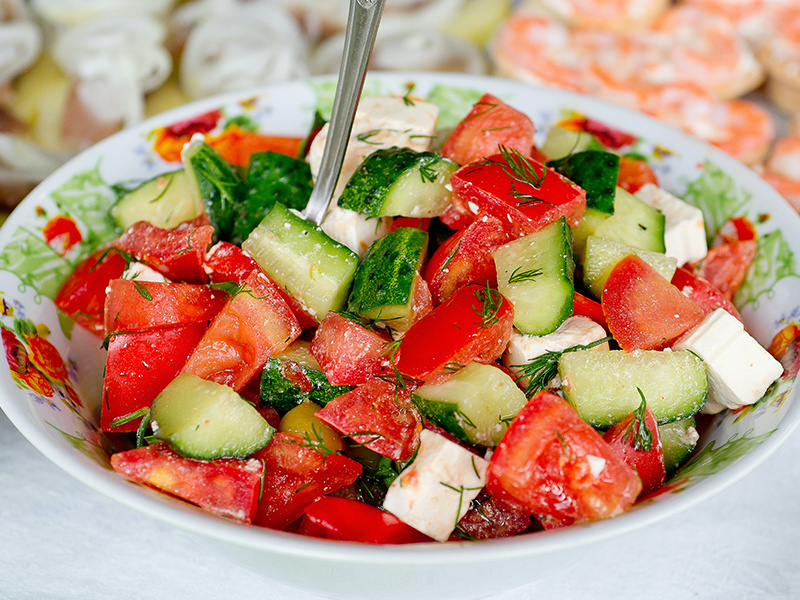Shirazi Salad: Recipe, Calories, History, Ingredients
The people of Shiraz are proud of their city’s culinary tradition and the popularity of Shirazi Salad. They are known for their great hospitality and enjoyment of fine cuisine. Shirazi people are proud of their unique food and frequently present it to visitors and guests. Shirazi Salad, originating in the Iranian city of Shiraz, has gained appeal not only in Iran but also globally. The salad’s refreshing taste, simplicity, and cultural importance have contributed to its popularity. Let’s learn more about Shirazi Salad ingredients.
Shirazi Salad Overview
Shirazi Salad has spread beyond Shiraz and is now considered a traditional Persian salad. Its popularity has extended across Iran and beyond, and it is now a popular dish in Persian restaurants around the world. The salad’s simplicity and versatility have contributed to its ongoing popularity since it can be easily altered to suit a variety of tastes and preferences.
This Salad pays respect to the city of Shiraz, which has long been a center of culture, poetry, and culinary traditions in Iran. Shirazi Salad is frequently offered at important occasions and gatherings such as weddings, family reunions, and picnics. It is shared among guests as a sign of warmth and welcome, and it represents hospitality and generosity.
Shirazi Salad’s core ingredients stay consistent, but variations include bell peppers, radishes, or pomegranate seeds to add depth and complexity.
Shirazi Salad History
Shirazi Salad’s history is connected with the rich culinary legacy of the Iranian city of Shiraz. For years, the salad has been a staple in Persian food, reflecting the region’s native ingredients and spices. Shirazi Salad is said to have originated in the ancient Persian Empire thousands of years ago. The area around Shiraz has a rich agricultural history and has been praised for its lush fields and excellent climate for growing fruits and vegetables.
The salad’s basic yet harmonious combination of cucumbers, tomatoes, onions, and herbs exemplifies the region’s agricultural richness. These components are widely available in the region, especially during the hot summer months when the salad’s flavors and textures are most refreshing.
Shirazi Salad Recipe Easy
Shirazi Salad Ingredients: 2 medium cucumbers, 2 medium tomatoes, 1 small red onion, 1/4 cup fresh mint leaves, 1/4 cup fresh parsley leaves, Lemon Juice, 2 tablespoons extra-virgin olive oil, Salt and pepper to taste
Shirazi Salad is a tasty and refreshing Persian salad. To create it, dice two cucumbers and two tomatoes, finely cut a small red onion, and combine with 1/4 cup fresh mint and parsley leaves. Whisk together the juice of 1-2 lemons, 2 tablespoons olive oil, salt, and pepper in a separate bowl. Pour the dressing over the vegetable mixture and gently toss to coat. Let it sit for 10-15 minutes to allow the flavors to blend. If desired, garnish with more herbs. Chill and serve as a side dish or topping for grilled meats.
The vivid tastes of the fresh ingredients shine through in this simple and healthy salad. Feel free to experiment with different ingredients, such as bell peppers or pomegranate seeds. Enjoy your healthy dish of salad with your friends and family.
What to Eat with Shirazi Salad?
Shirazi Salad is a flexible choice that goes well with a variety of meals. It complements grilled meats such as kebabs, chicken, or lamb, offering a refreshing contrast to their tastes. It also adds a fresh and tangy touch to Persian rice dishes, Middle Eastern platters, and Mediterranean food. The salad can also be used as a filler or topping for wraps, sandwiches, and burgers. Its crisp textures and vivid tastes make it a great summer side dish for backyard barbecues and picnics.
The salad’s straightforward blend of cucumbers, tomatoes, onions, and herbs allows it to pair well with a variety of cuisines. You can experiment and find the combination you like best. Shirazi Salad gives a burst of freshness and compliments a range of foods, whether served as a side dish or as part of a larger buffet.
Shirazi Salad Calories
Shirazi Salad is a light and delicious salad that is low in calories in general. A normal portion of the salad, which includes cucumbers, tomatoes, onions, and herbs, has about 30-50 calories per serving. Shirazi Salad is a popular, healthy, and nutritious option due to its high water content, fiber, and vitamins from vegetables and herbs.
It is a popular choice for those who want to eat a balanced diet or control their calorie intake. The salad is also appropriate for a wide range of people and dietary needs. Being naturally gluten-free, vegan, and vegetarian gives it an adaptable alternative for individuals with dietary limitations or preferences.
How to Enhance Shirazi Salad Recipe
To enhance the salad flavor and make your preferred one, you can add a few herbs and spices. Sprinkle dried mint for extra freshness or sumac for tanginess. Crushed dried Persian lime can provide a unique citrusy note, while fresh dill adds a mild herbal taste. A touch of freshly ground black pepper adds subtle spiciness. Experiment with several flavors to find your favorite. Enjoy the process of figuring out the ideal combination of herbs and spices to take your salad to the next level.
Last Words
Shirazi Salad’s popularity extends beyond its flavor and components. It reflects a cultural and emotional link to Iranian customs, seasonal foods, and the delight of sharing a meal with loved ones. Shirazi Salad’s popularity and affection among Iranians reflects a deep appreciation for Persian cuisine’s basic pleasures and tastes. Shirazi Salad Calories are also adequate for athletes who want to eat healthy food. If you’ve heard of Shirazi Salad from your Iranian friends or online, try this simple and straightforward dish at home and give it a try.
Are you planning to travel to Iran and looking for an Iran travel agency? Check out our Iran tours and Iran food tour.








Leave a Reply
Want to join the discussion?Feel free to contribute!